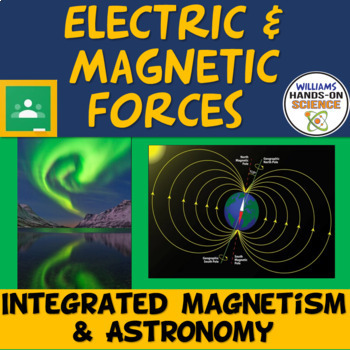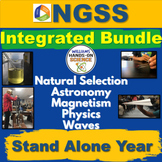Northern Lights Activity Electromagnetic Forces Auroras Solar Storms Sunspots
- Google Slides™

What educators are saying
Also included in
- Looking for a complete, standalone year-long curriculum for integrated NGSS Physics, Energy, Waves, Astronomy, Earth’s History, Science and Engineering Practices, Crosscutting Concepts, and Evolution? Look no further than this student-centered, inquiry-based, hands-on bundle! Designed to align withPrice $205.00Original Price $366.00Save $161.00
- This 2-3 week, hands-on, engaging and easy to deliver unit is so fun to teach! Save time and money and let me plan your electricity and magnetism unit for you! If you are teaching the NGSS disciplinary core idea PS2.B: Types of Interactions (electricity and magnetism), this resource is perfect for yPrice $17.00Original Price $25.00Save $8.00
Description
This engaging, Google Ready, NO PREP resource will wow your students! This resource is great as an introduction, a scaffold, review or sub plan. If you are teaching the NGSS standard PS2.B: Types of Interactions: Electric and magnetic (electromagnetic) forces, this resource is perfect for you!
What Students Do:
- First I show an amazing video about the Northern Lights as the engage to get the student’s attention. Students are asked, “What causes the Northern Lights, also known as the Aurora Borealis?” without any prior knowledge for metacognitive purposes.
- Students then make an interactive graph of Sunspot Number Every 2 years from 2004-2020.
- Students then compare the graph of sunspot numbers to the number of geomagnetic storms that cause the Northern Lights/Aurora Borealis.
- Students then watch a video called, “What Is An Aurora?” and Revise their background knowledge: What causes the northern lights, also known as the Aurora Borealis? Use Sunspots, Solar Storms and Electrically Charged Particles in your answer.
Students will then wrap up the lesson with answering the following 4 questions:
1. Cause and Effect: What is the relationship between the two data sets?
2. Patterns: How can you explain this pattern?
3. Patterns: Based on the data, what will happen in the future?
4. When solar storms make it through earth’s protective magnetic shield, what are two things that we can experience on earth?
This assignment took 45 minutes for my 8th graders.
You get the following:
-4 Google Slides Student Copy
-12 Google Slides Slideshow for classroom management, pacing and the key.
-Link to the latest sunspot data.
The following concepts are included:
Magnetic field or Magnetosphere
Magnetic Poles
Earth as a large magnet
Sun Spots
Solar Flares
Solar Wind
Magnetically Charged Particles
North and South Poles
Aurora or Northern Lights
Click here and save over 40% by buying my Electricity Magnetism
Bundle that has all my forces, energy, astronomy, waves and evolution resources.
NGSS Standards:
PS2.B: Types of Interactions
Electric and magnetic (electromagnetic) forces can be attractive or repulsive, and their sizes depend on the magnitudes of the charges, currents, or magnetic strengths involved and on the distances between the interacting objects. (MS-PS2-3)
Forces that act at a distance (electric, magnetic, and gravitational) can be explained by fields that extend through space and can be mapped by their effect on a test object (a charged object, or a ball, respectively). (MS-PS2-5)
ESS1.B: Earth and the Solar System
The solar system consists of the sun and a collection of objects, including planets, their moons, and asteroids that are held in orbit around the sun by its gravitational pull on them
Analyzing and Interpreting Data, Scientific investigations produce data that must be analyzed in order to derive meaning. Because data patterns and trends are not always obvious, scientists use a range of tools—including tabulation, graphical interpretation, visualization, and statistical analysis—to identify the significant features and patterns in the data. Scientists identify sources of error in the investigations and calculate the degree of certainty in the results. Modern technology makes the collection of large data sets much easier, providing secondary sources for analysis.
Asking questions and defining problems in grades 6–8 builds from grades K–5 experiences and progresses to specifying relationships between variables, and clarifying arguments and models.
Ask questions that can be investigated within the scope of the classroom, outdoor environment, and museums and other public facilities with available resources and, when appropriate, frame a hypothesis based on observations and scientific principles. (MS-PS2-3)
CCC1: Patterns
Observed patterns of forms and events guide organization and classification, and they prompt questions about relationships and the factors that influence them.
Cause and Effect
Empirical evidence is required to differentiate between cause and correlation and make claims about specific causes and effects. (HS-LS3-1), (HS-LS3-2)
Stability and Change
Much of science deals with constructing explanations of how things change and how they remain stable. (HS-ESS2-7)
Feedback (negative or positive) can stabilize or destabilize a system. (HS-ESS2-2)
Thank you for taking a look!
TERMS OF USE
• All rights reserved by Williams Hands On Science, Inc.
• This product is to be used by the original purchaser only.
• Intended for classroom and personal use only.
• Copying for more than one teacher, classroom, department, school, or school system is prohibited.
• This product may not be distributed or displayed digitally for public view.
• Failure to comply is a copyright infringement and a violation of the Digital Millennium Copyright Act (DMCA).
If there are any errors or questions, please contact me through TpT or email me at:
williamshandsonscience@gmail.com
Thank you for taking a look!
Please follow me on TpT for new products and check me out on Instagram for my products in action!
https://www.instagram.com/williams_hands_on_science/







